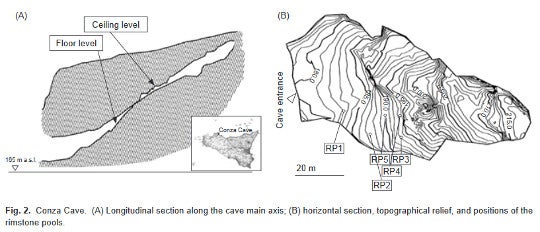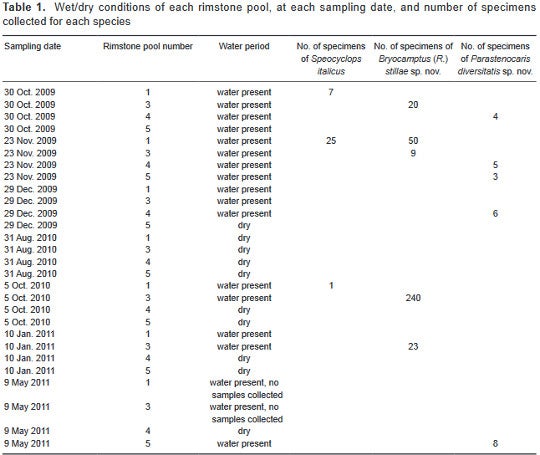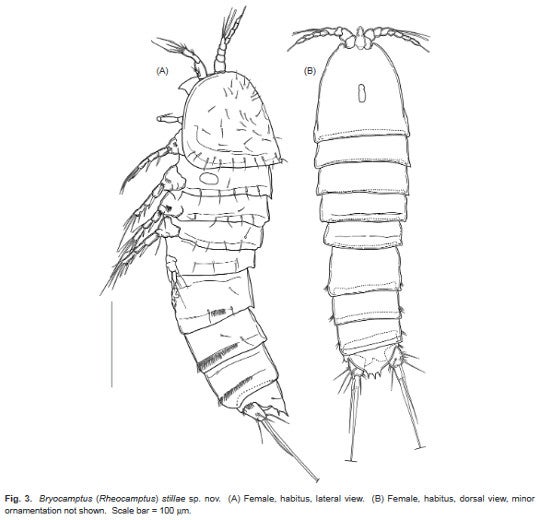This article was published in Scientific American’s former blog network and reflects the views of the author, not necessarily those of Scientific American
Most people who have heard of copepods – and there are precious few in this world – know them from the ocean, where they are a common member of the drifting life called plankton. They’re little crustaceans, and more or less unremarkable looking. Here is one.

By Kils at English Wikipedia - Transferred from en.wikipedia to Commons by Banaticus using CommonsHelper., CC BY-SA 3.0, https://commons.wikimedia.org/w/index.php?curid=6716041
But copepods don’t just live in the ocean. They also hide, like Gollum, in hidden pools and cavities in the Earth. These tiny cracks, crevices, and pockets of water are an invisible ecosystem teeming with life that humans can only imagine because we are far too large to ever visit them. The habitats are so small and varied that different rare species may live in labyrinths just yards from each other, but never meet.
On supporting science journalism
If you're enjoying this article, consider supporting our award-winning journalism by subscribing. By purchasing a subscription you are helping to ensure the future of impactful stories about the discoveries and ideas shaping our world today.
Their home is called the epikarst, and it is a layer of Earth found in mostly limestone, dolomite, and gypsum rock between the dirt and any cave systems below, a layer called karst. It isn’t quite soil and it isn’t quite stone, and water that percolates through it may be captured or diverted in unexpected directions by fractures and liquid-filled cavities in the rock. This network of spaces can form a crazy quilt of habitats for a variety of different organisms. Most prominent is a bumper crop of small crustaceans, particularly our copepod friends. More on them later.
The diversity is high enough to rival that in the caves below, and the ecological niches either so unique or cut off by the geometry of rock within the epikarst as to form what are effectively islands of life, subject to the same evolutionary forces found on their much larger cousins in the ocean (an important field of biology called “Island biogeography”, famously pioneered by Robert MacArthur and E.O. Wilson).
When water that has traveled through this micro-warren reaches any caves below, it drips out of the ceiling and may form quiet rimstone infinity pools bordered by ripply dams deposited by minerals that precipitate from the dripwater. They are usually serene, their glassy surfaces marred only by the occasional drop (which may accelerate to a proper shower after topside downpours).

By Jojo, en:Jojo_1, pl:Jojo - Own work, CC BY-SA 3.0, https://commons.wikimedia.org/w/index.php?curid=1186841
By Steve46814 - Own work, CC BY-SA 3.0, https://commons.wikimedia.org/w/index.php?curid=7689407
When storms wash through this warren, the tiny animals that live there must hold on with everything they've got, in some cases resorting to structures including – I am not making this up -- “anal teeth”, for fear of being washed down into a place where they cannot survive.
Since we lack the sort of shrink rays regularly found in B-grade sci-fi films, none of us can visit the epikarst in person. We must rely on those unfortunates swept out of the rock by water and into caves below to tell us what might be living up there (which begs the question: what sorts of animals that are *really good* at clinging to cracks might be up there? And what hides in the layer below the karst?). As a result of our inability to thoroughly explore it, it is a great source of new species.
Such places include the rimstone pools of Conza Cave near Palermo, Sicily. Conza Cave is relatively small. Just 100 meters long, it slopes upward 20 meters from the entrance and contains five rimstone pools.

From Cottarelli et al. 2012.
The rock matrix in which it formed is a mixture of limestone, dolomite, and biolitite. The cave is dead; that is, whatever hydrological forces acted to form it have ceased, and it no longer floods. The only water infiltration is through the drips from the ceiling into the rimstone pools. The pools are on top of boulders without an outlet, and are effectively sealed off from the rest of the cave by an impermeable calcite coating on their bottoms and edges, formed when the mineral precipitates from the percolation water. The pools, too, are thus islands – islands that periodically vanish.
The overburden – the layer of Earth between the ceiling and the surface – is also relatively thin at Conza Cave, measuring just 14 meters (46 feet). The water storage capacity of this layer is therefore small, and when the rains disappear in summer due to the Mediterranean climate, the drips drop off and the pools dry up through at least late spring and early summer, and sometimes also through the winter. Copepods do not have a resting stage capable of surviving dry conditions (unlike the tardigrades recently covered here). So any copepods washed out of the ceiling into the pools of this cave are doomed to die.
Some intrepid Italian caver-scientists from the University of Catania decided a few years ago to study what they found in these pools. They wanted to test whether the pools were colonized only by organisms dripping from the epikarst, and whether even though the layer is thin and rain is often scarce, that the epikarst above Conza Cave can be a permanent refuge for these organisms during hot dry weather. Since none of the pools were connected to each other, the five pools were also microsampling devices for gauging the biota of the epikarst above on a fine scale.
The spaces in the epikarst above must have retained some water throughout the year, as the scientists observed the copepods instantly reappeared in their pools with the onset of each rainy season and the re-formation of the pools.

From Cottarelli et al. 2012.
What the scientists found over three years of monitoring those pools revealed something else amazing: three different copepod species consistently filled the same pools mere meters away from each other – two out of three of them new to science -- indicating that in the rock above the ceiling were atolls of life whose inhabitants never seemed to mingle.
This is what a cave copepod looks like. It was one of the two species new to science. Note how much shorter their appendages are compared to their marine cousins.

From Cottarelli et al. 2012.
Subterranean copepods also tend to share certain features. They have extended reproductive periods, to maximize the chance of partners running into one another at receptive times. That held true for B. stillae in this study – invidividuals in all life stages were found throughout the entire sampling period. Such copepods also tend to produce just a few large eggs, an adaption to “adversity” found in species in many habitats. B. stillae had just five or six eggs per female, and they were the largest diameter ever recorded for its genus.
Such creatures also tend to have evolved special methods for clinging to their cracks, to avoid being swept too deep with the inexorable pull of water. In the case of B. stillae, this includes a long body with short, stout limbs bristling with little spines. It even includes a few teeth on their “anal operculum”, a covering for the area in question. You can see three of them on the image at right above at the base of the copepod's body, between the two long spines. It’s not “Hold on to your butt,” -- it’s “Hold on with your butt”. These little guys – like all inhabitants of the epikarst -- are literally holding on for their dear lives with everything they've got.
The pools were roughly divided into two groups. Rimstone pools 4 and 5 consistently contained Parastenocaris diversitatis, a new species. The two pools were only 7 meters apart. Pools 1 and 3, about 10 meters apart, contained Bryocamptus stillae and Speocyclops italicus, and in one instance, pool 1 contained both. The two groups of pools were separated by 10-16 meters.
Pool No. 2 contained no copepods at all. The water that fed it must have come from a copepod desert, or from a fracture system where the copepods were easily able to prevent themselves from falling from the ceiling.
The authors suggest that there are two separate percolation units feeding the two groups of pools, perhaps divided by microfractures of different sizes or other characteristics that favor certain species over others. P. diversitatis, for example, is skinnier than B. stillae, and was found much less often in the pools. That may be because it can wedge itself into much tighter cracks than B. stillae, which also reduces the chances it will wash out of the ceiling.
Many other organisms were found in the pools besides copepods. The scientists also saw 12 tardigrades (water bears); 249 nematodes (roundworms); perhaps not surprisingly, 72 earthworms; and two mites. They also saw 102 albino ostracods – the same group of organisms that produces the firefly-like displays that so mesmerized me in the Caribbean a few years ago – but only in Pool 1.
Finding copepods with such restricted distributions was not entirely unexpected. Subterranean copepod species had already been known to have distributions of just a few hundred meters, and the epikarst fauna to be divided into ecological “blocks” based on hyperlocal environmental conditions., Still, finding entirely separate groups within just meters of each other seems extraordinary to me. If you extrapolate this finding to the entire karst-bearing land surface of the planet, the potential diversity seems staggering. Imagine all the little animals that could be squirreled away in all the little cracks and crevices inside millions of square miles of land, tucked far from the probing gaze of science.
Note: The post was inspired by another on the same topic at Catalogue of Organisms. If you like this blog and are into serious taxonomy, you should check it out!
Reference
Cottarelli, Vezio, Maria Cristina Bruno, Maria Teresa Spena, and Rosario Grasso. "Studies on subterranean copepods from Italy, with descriptions of two new epikarstic species from a cave in Sicily." Zoological Studies 51, no. 4 (2012): 556-582.